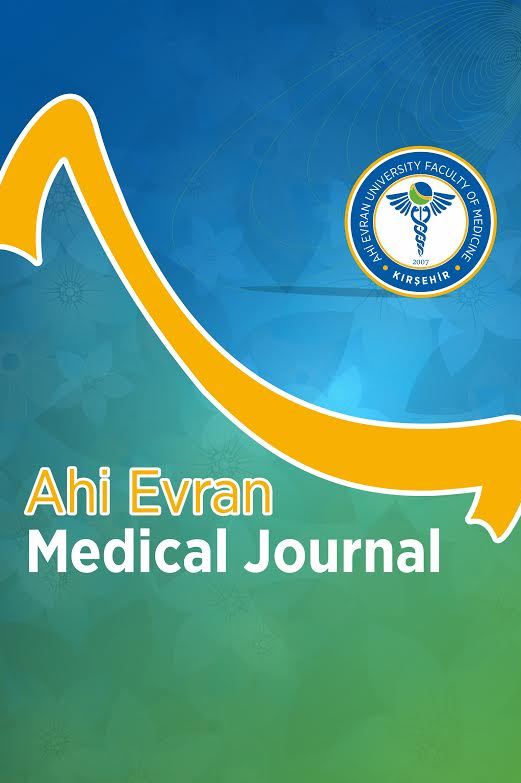Adenotonsiller Hipertrofinin Neden Olduğu Pediatrik OSAS’ın Koroid Kalınlığı Üzerine Etkisi
adenotonsiller hipertrofi, koroid kalınlığı, pediatritrik obstrüktif uyku apne sendromu
Does Pediatric OSAS with Adenotonsillar Hypertrophy Impact on the Choroidal Thickness of Children?
adenotonsillar hypertrophy, choroidal thickness, pediatric obstructive sleep apnea syndrome,
___
- 1. Ehsan Z, Ishman SL. Pediatric Obstructive Sleep Apnea. Otolaryngol Clin North Am. 2016;49(6):1449‐1464.
- 2. Yenigun A, Elbay A, Hafiz AM, Ozturan O. Choroidal thickness evaluation in pediatric patients with adenotonsillar hypertrophy. J Laryngol Otol. 2017;131(9):768‐772.
- 3. Cakabay T, Bezgin SÜ, Bayramoglu SE, Sayin N, Kocyigit M. Evaluation of choroidal thickness in children with adenoid hypertrophy. Eur Arch Otorhinolaryngol. 2018;275(2):439‐442.
- 4. Darrow DH, Siemens C. Indications for tonsillectomy and adenoidectomy. Laryngoscope 2002;112(8): 6‐10.
- 5. Nickla DL, Wallman J. The multifunctional choroid. Prog Retin Eye Res. 2010;29(2):144‐168.
- 6. Bayhan HA, Bayhan SA, İntepe YS, Muhafiz E, Gürdal C. Evaluation of the macular choroidal thickness using spectral optical coherence tomography in patients with obstructive sleep apnoea syndrome. Clin Exp Ophthalmol. 2015;43(2):139‐144.
- 7. Karaca EE, Ekici F, Yalçın NG, Çiftçi TU, Özdek S. Macular choroidal thickness measurements in patients with obstructive sleep apnea syndrome. Sleep Breath. 2015;19(1):335‐341.
- 8. Phadikar P, Saxena S, Ruia S, Lai TY, Meyer CH, Eliott D. The potential of spectral-domain optical coherence tomography imaging-based retinal biomarkers. Int J Retina Vitreous 2017;3(1):1-10.
- 9. Fujiwara A, Shiragami C, Shirakata Y, Manabe S, Izumibata S, Shiraga F. Enhanced depth imaging spectral-domain optical coherence tomography of subfoveal choroidal thickness in normal Japanese eyes. Jpn J Ophthalmol. 2012;56(3):230‐235.
- 10. Spaide RF, Koizumi H, Pozzoni MC. Enhanced depth imaging spectral-domain optical coherence tomography. Am J Ophthalmol. 2008;146(4):496-500.
- 11. Sahin M, Sahin A, Kilinç F, Gürsel ÖZ, Karaalp U,Yüksel H. Evaluation Of The Peripapillary Retinal Nerve Fiber Layer And Subfoveal Choroidal Thickness In Naive Patients With Diabetes Mellitus With Spectralis OCT. Dicle Med J. 2016;43(3):435-440.
- 12. Tonini M, Khayi H, Pepin JL, et al. Choroidal bloodflow responses to hyperoxia and hypercapnia in men with obstructive sleep apnea. Sleep 2010;33(6):811‐818.
- 13. Xin C, Wang J, Zhang W, Wang L, Peng X. Retinal and choroidal thickness evaluation by SD-OCT in adults with obstructive sleep apnea-hypopnea syndrome (OSAS). Eye 2014;28(4):415‐421.
- Yayın Aralığı: Yılda 3 Sayı
- Başlangıç: 2017
- Yayıncı: Kırşehir Ahi Evran Üniversitesi
Tekrarlayan Gebelik Kayıplı Hastalarda Kromozom Analizinin Yeri
Burhan BALTA, Murat ERDOĞAN, Aslıhan KİRAZ, Zeki YILMAZ
Postoperatif Pulmoner Komplikasyonların Öngörülmesinde Belirteç Karşılaştırılması; Asa ve Ariscat
Covid 19 Pandemisi Sırasında Kullanılan Farmakolojik Ajanların Gözden Geçirilmesi.
Sağlıklı Bireylerde İki Farklı Optik Koherens Tomografi Anjiografi Cihazının Karşılaştırılması
Sebile ÇOMÇALI, Cemal ÇAVDARLI, Mehmet Numan ALP
Adenotonsiller Hipertrofinin Neden Olduğu Pediatrik OSAS’ın Koroid Kalınlığı Üzerine Etkisi
Laparoskopik Sleeve Gastrektomi Sonrası Morbid Obez Hastalarda Akdeniz Diyetinin Etkinliği
Mehmet Nuri KOŞAR, Umut R. GÜNDÜZ, Onur İlkay DİNÇER, Tuğrul ÇAKIR
Sercan ÖZKAÇMAZ, İlyas DÜNDAR, Nazım KANKILIÇ, Mesut ÖZGÖKÇE, Abdullah GÜL, Rahmi ASLAN
Nd:YAG Lazer Onikomikoz Tedavisinde Etkili midir?
Serkan DÜZAYAK, Orhan ÖZGÖZTAŞI
Doğum Şeklinin Umbilikal Kord Kanındaki Tiyol-Disulfid Dengesine Etkisi
Selda SONGUR DAĞLI, Recai DAĞLI
Asemptomatik Safra Taşlarında Kolesistektomi Sıklığı ve İlişkili Faktörlerin Araştırılması
Ali KIRIK, Ali Cem YEKDEŞ, Uğur ERGÜN, Burak ALP, Merve Nur AK, Teoman DOĞRU
